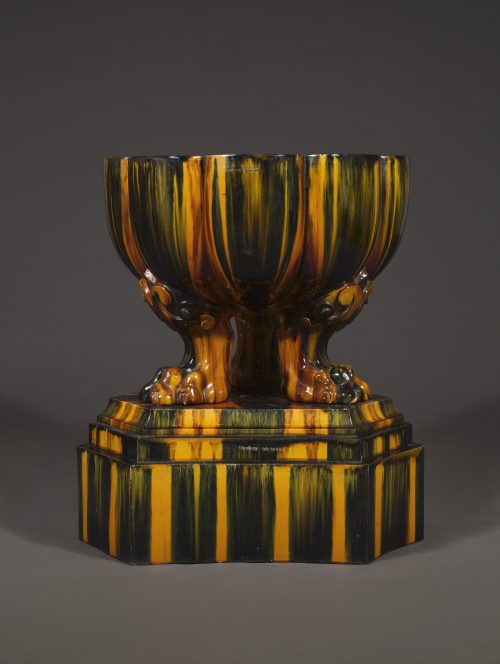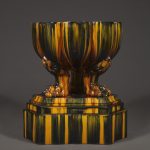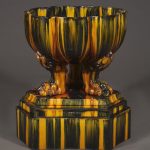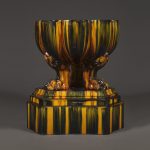11078 A HIGHLY UNUSUAL CERAMIC POLYLOBÉE INDOOR JARDINIÈRE BY CLÉMENT MASSIER French. Circa 1890. Measurements: Height: 33″ (83 cm) Diameter: 26” (66 cm)

Research
Of enameled stoneware, with expansive polylobée upper section, central drainage hole. Supported by a tripod of three clawed lion feet, the whole on a stepped plinth. Glazed with a high-gloss, regularly streaked pattern. One foot replaced.
Marks:
Stamped:
Clément Massier, Golfe Juan
The design of the present piece is an example of well-executed nineteenth century eclecticism. The polylobée shape of the upper section is reminiscent of medieval ceramics, which were in turn probably imitating pieces of middle and far eastern origin. The lion feet however are highly classical. That these two influences are combined so seamlessly is testament to the excellent skill of the makers and designers of the Massier ceramics factory who made it.
The Massier family includes some of the most famous of French nineteenth century ceramicists. Most important of all was Clément (1844-1917), who was of international renown as an innovator in the realm of ceramics. He brought to bear Moorish and Hispanic influences on his design, and most importantly developed new glazes. Some, as in the present piece, explored interesting variation in color and patterning, but Massier also developed new iridescent glazes that would prove to be an immediate hit and become a celebrated feature of the art nouveau period. These effects were obtained through the development of unique chemical compounds containing high levels of copper and silver oxide, fired in a smoky kiln.
Massier was successful in recruiting talented artists and designers. In 1859 Gandolfi Gaetano began working at the factory. This Italian ceramicist was the first to introduce the innovative and daring approach to design for which the company would become famous. By 1871 the factory began to exclusively produce art ceramics. It was in 1884 that Clément moved the business to the picturesque resort of Golfe Juan on the French Riviera close to Vallauris where there remains a tradition of ceramic production; the town is still home to the Biennale Internationale de la Ceramique. By this time the factory employed an impressive 120 workers.
The company’s Art Nouveau credentials were improved yet further by the recruitment of Lucien Lévy-Dhurmer in 1887. More famous as a painter, Lévy-Dhurmer would stay until 1895 adding originality, variety and fashion to the designs, and heightening the popularity of the company’s wares with an increasingly elite clientele. In 1889 at the Paris Exposition Universelle, under the shadow of the newly constructed Eiffel Tower, the company caused a great stir and won a golden medal for their extraordinary glazes. On page 303 of his 1907 travel book Rambles in Provence and the Riviera, Francis Miltoun gives us some insight on the Massier factory:
The establishment of Clément Massier is famous for the quality and excellent design of its product. The proprietor in the early days, by his natural taste and studies, brought his work to the attention of such masters in art as Gérôme, Cabanal, Berne-Bellecour and Puvis de Chavannes, all of whom encouraged him to develop his abilities still further. Study of antique forms and processes threw a new light upon the art, or at least a newly reflected light, and at last were produced those wonderful iridescent effects and enamels which were a revelation to lovers of modern pottery. Their success was achieved at the great Paris Exposition of 1889, since which time they have been the vogue among the “clientele élégant du littoral” as the cicerone who takes you over the Ceramic Musée tells you.







Comments are closed.